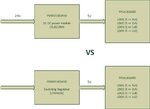flote21
Advanced Member level 1
Hello people, I am designing the power supply chain of an ALTERA FPGA and I am wondering about which power converter is better to use. My plan is to create a power board to convert from 24v to 5v and from this power board drive 5v to the FPGA board. Then I will use some LDO to generate from 5v the FPGA voltages (See picture attached). My big question is about which component is better to convert 24v => 5v. I was thinking to use a DC-DC power module (ISL8216M instead of a
switching regulator (LTM4606) because it is easier to implement (you only need a pair of coupling caps and go) you will have lower switching noise and lower heating dissipation. But I would like which are the drawbacks of using the DC-DC
power module and if some one has another good idea, please tell me.
Thanks a lot!

switching regulator (LTM4606) because it is easier to implement (you only need a pair of coupling caps and go) you will have lower switching noise and lower heating dissipation. But I would like which are the drawbacks of using the DC-DC
power module and if some one has another good idea, please tell me.
Thanks a lot!
